I. Background
Since the 21st century, with the rapid development of China’s economy and society, people’s work and lifestyle have changed, and the physical activity of residents has decreased significantly. Insufficient physical activity is the fourth independent factor leading to human death. Sports activities have become the most active, effective and economical way of life to enhance the national physique and improve the health level.
Our government attaches great importance to the important role of sports activities in strengthening physical fitness and improving health level. In 1995, the State Council promulgated and implemented the Outline of the National Fitness Program; In 2007, the State Council issued "Opinions on Strengthening Youth Sports to Enhance Youth Physical Fitness"; In 2014, the State Council issued "Several Opinions on Accelerating the Development of Sports Industry and Promoting Sports Consumption"; In 2016, the State Council issued the Outline of Healthy China 2030, which made clear arrangements for developing mass sports activities, advocating the new fashion of national fitness and promoting the construction of a healthy China.
Since the implementation of the National Fitness Program in 1995, China’s mass sports undertakings have developed vigorously, sports administrative departments at all levels have actively implemented the Outline of the National Fitness Program, and the youth sports work has been continuously promoted, and the awareness of sports activities has been significantly enhanced; The average area of gymnasiums and gymnasiums in China is 1.57 square meters, and the proportion of people who regularly participate in sports activities is 33.9%. The forms of sports activities for the elderly are rich and colorful, and the quality of life is improved. According to the data of the sixth census, the average life expectancy in China is 74.9 years. The social atmosphere in which sports activities have become an important means to keep fit has been formed.
However, we should be aware that the role of sports activities in strengthening the national physique and improving the health level has not been fully exerted, and there is still a big gap from the requirements of a healthy China. According to relevant national survey data, although the proportion of people who regularly participate in sports activities in China has increased year by year, the overweight rate and obesity rate of residents have also continued to increase, and the changes of indicators such as adolescent endurance, adult muscle strength and endurance, and elderly muscle strength are not optimistic. The incidence of chronic non-communicable diseases such as cardiovascular disease and diabetes is on the rise, and many research results of sports activities in the field of health promotion have not been fully applied to practice. Most residents have great blindness when participating in sports activities. There is still much room for improvement in physical fitness and disease prevention and control. Therefore, it is urgent to issue an authoritative guide to physical fitness activities at the national level to guide residents to engage in physical fitness activities scientifically.
According to the actual situation of China residents’ participation in physical fitness activities, the National Fitness Guide systematically summarizes and integrates the relevant national research results in the Tenth Five-Year Plan, the Eleventh Five-Year Plan and the Twelfth Five-Year Plan, and is compiled based on the measured data of China residents’ physical fitness. It mainly includes the effect of physical fitness activities, the test and evaluation of sports ability, the principles of physical fitness activities, the guiding scheme of physical fitness activities and so on.
Second, the effect of physical fitness activities
In ancient China, there was a written record of improving human health through introduction. A large number of modern research results have confirmed that regular participation in physical fitness activities can effectively enhance physical fitness, prevent diseases, and improve study and work efficiency.
(A) to enhance physical fitness, improve health.
Constitution refers to the comprehensive and relatively stable characteristics of human morphological structure, physiological function and psychological factors on the basis of heredity and acquisition. Physical fitness activities can improve the cardiopulmonary function, muscle strength, flexibility, balance and reaction ability of human body, and improve body composition, so as to achieve the effect of enhancing physical fitness and improving health level.
1. Improve cardiopulmonary function
Cardiopulmonary function is one of the core factors affecting physical fitness and health. Low cardiopulmonary function can lead to an increased risk of premature death. Regular physical activities can improve cardiac contractility and vital capacity, regulate blood pressure, improve blood lipids, have a good impact on cardiopulmonary function, and obviously improve the cardiopulmonary function and health level of teenagers, middle-aged people and the elderly.
2. Improve body composition
Body composition refers to various substances that make up the body and their proportions, which are generally expressed by body fat content and muscle weight and their ratios. Studies have confirmed that excessive body fat, especially abdominal fat, can induce cardiovascular diseases and metabolic diseases. Physical activities based on aerobic exercise can increase fat consumption, reduce body fat content, increase muscle weight and improve body composition.
3. Increase muscle strength
Strength training can improve muscle strength and muscle fatigue resistance, promote the growth and development of teenagers, make their physique stronger, prevent symptoms such as waist pain, shoulder and neck pain caused by muscle strength attenuation, improve body balance, prevent the elderly from falling, maintain bone health, and prevent and delay osteoporosis.
4. Improve flexibility
Flexibility is not only an important sports skill, but also an important activity ability in daily life. Regular traction exercises can improve the elasticity of muscles and ligaments, increase the range of physical activities of teenagers, have beautiful body posture, reduce muscle strain, and prevent and treat joint diseases of middle-aged and elderly people.
5. Improve the happiness index
Physical exercise is an effective means of psychological intervention. Physical fitness activities can increase people’s sense of pleasure, make people relax, relieve stress, form a good psychological state, get physical and psychological satisfaction, make teenagers full of vitality, middle-aged and elderly people full of vitality, and improve happiness index.
(B) prevention and treatment of diseases, improve the quality of life
Physical activity can improve the functional level of human organs, enhance the body’s immunity and prevent diseases, especially for chronic non-communicable diseases. Chronic non-communicable diseases, including cardiovascular diseases, diabetes and osteoporosis, are important diseases that endanger the health of Chinese residents. Regular physical activities can effectively control the inducing factors of chronic non-communicable diseases, prevent the occurrence of chronic non-communicable diseases, and at the same time, it is also an effective means to treat chronic non-communicable diseases, improve the quality of life and reduce premature death caused by improper lifestyle and insufficient physical activity.
1. Cardiovascular disease
The prevalence of cardiovascular disease among Chinese residents is on the rise, and cardiovascular death ranks first among the total causes of death among urban and rural residents. Regular physical activities can reduce the risk factors of cardiovascular diseases, effectively prevent cardiovascular diseases and promote the rehabilitation of patients with cardiovascular diseases by improving heart function and vascular elasticity, lowering blood pressure, reducing inflammatory factors and regulating blood lipids.
2. Diabetes
Diabetes is one of the common chronic diseases, and type 2 diabetes is the most common. Regular physical activity can regulate glucose metabolism, reduce blood sugar, improve the sensitivity of target cells to insulin, effectively prevent and treat type 2 diabetes, and delay the occurrence and development of complications. Physical activity can enhance the physique of diabetic patients and improve their quality of life.
3. Overweight and obesity
Overweight and obesity are characterized by weight gain and are usually expressed by body mass index (BMI). Overweight and obesity are related to many chronic diseases, including hypertension, coronary heart disease, diabetes, some cancers and various musculoskeletal diseases. The most effective means to prevent and reduce obesity are physical activity and diet balance. Physical activity is the most active method to prevent and control obesity, which can help obese people control their weight, improve their physiological function, prevent weight rebound after losing weight and reduce the occurrence of chronic diseases related to obesity.
4. Osteoporosis
Osteoporosis is a bone tissue disease characterized by decreased bone density, changes in microstructure of bone tissue, and increased fracture susceptibility. Physical activity helps to increase bone mass, improve bone structure, slow down the loss of bone mass caused by aging, prevent falls and reduce the risk of osteoporotic fractures by enhancing muscle strength and balance.
5. Cancer
Cancer, also known as malignant tumor, ranks second among the total causes of death among Chinese residents. Physical activity can reduce the risk of breast cancer, colon cancer, lung cancer, prostate cancer and other cancers, relieve the pain of postoperative treatment of cancer patients, and improve the survival rate and quality of life of cancer patients. The World Health Organization estimates that more than 30% of cancers can be prevented by physical activities.
6. Depression
Depression, also known as depressive disorder. In recent years, the incidence of depression in China is on the rise. Physical fitness activities can change the chemical composition of the brain, cause good emotional and state responses, effectively prevent depression, and have a positive intervention effect on patients with mild to moderate depression.
(C) improve the efficiency of study and work
Physical fitness activities can improve people’s cognitive ability and make people concentrate. Regular physical fitness activities can reduce the release of inhibitory neurotransmitters, delay central fatigue, have a good impact on the nervous system, help improve the learning efficiency and academic performance of teenagers, extend the effective working hours of adults and improve work efficiency.
Third, the sports ability test and evaluation
Sports ability refers to the ability of the human body to engage in sports activities. The sports ability test and evaluation of this guide includes single sports ability test and evaluation and comprehensive sports ability evaluation. Before engaging in sports activities, the human body should comprehensively test and evaluate the indexes related to sports ability, so as to scientifically formulate personalized sports activities programs. At different stages of engaging in sports activities, we should regularly carry out sports ability tests to objectively evaluate the effect of sports activities and ensure the safety and effectiveness of sports activities.
(A) individual sports ability test and evaluation
Single exercise ability test includes aerobic exercise ability, muscle strength, flexibility, balance and reaction ability test. The evaluation of individual sports ability adopts a five-point system, with 5 being excellent, 4 being good, 3 being medium, 2 being poor and 1 being poor.
1. Aerobic exercise ability
Aerobic exercise ability reflects the ability of human body to carry out aerobic exercise for a long time, which is closely related to cardiopulmonary function. Strong aerobic exercise ability indicates good cardiopulmonary function. Good aerobic exercise ability is an important sign of good health. Regular participation in sports activities can maintain and improve the aerobic exercise ability of human body.
Maximum oxygen uptake is an important index to evaluate aerobic exercise ability.
2. Muscle strength
Muscle strength is the ability of muscle to overcome or resist resistance when it is tense or contracting. Muscle strength test indicators include grip strength, back strength, push-ups, sit-ups, vertical jump test and so on.
3. Flexibility, balance and reaction ability
Flexibility refers to the range of motion of each joint during physical activity and the elasticity and stretching ability of ligaments, tendons, muscles, skin and other tissues across the joint. Good flexibility can increase the range of motion and reduce sports injuries.
② Balance refers to the ability to maintain body posture or control the center of gravity. Balance ability is the basis of static and dynamic activities. Good balance ability can effectively prevent all kinds of injuries caused by falls.
③ Reaction ability mainly refers to the ability of the human central nervous system to consciously control the rapid movement of the skeletal muscle system after receiving certain instructions or stimuli, which embodies the coordination between the nerve and the muscle system.
(2) Comprehensive sports ability evaluation
Cardiopulmonary function is one of the most important factors affecting human health, and aerobic exercise ability is closely related to cardiopulmonary function. Therefore, aerobic exercise ability is ranked first in the comprehensive exercise ability evaluation system, with a weight of 40%.
Obesity can induce a variety of chronic diseases and become an important risk factor for public health. BMI is an index reflecting the degree of obesity. In view of the important role of BMI in the evaluation system of physical fitness and health, and its obvious influence on sports ability, BMI is included in the comprehensive evaluation system of sports ability, with a weight of 20%.
The calculation formula of BMI is: weight (kg) divided by the square of height (m) [BMI= weight (kg)/height 2 (m 2)]. The normal range of China people’s BMI is greater than 18.5 and less than 24, with BMI equal to or greater than 24 being overweight and equal to or greater than 28 being obese.
Muscle strength is closely related to exercise ability and quality of life, and its weight is 20%. The weights of flexibility, balance and responsiveness are 10%, 5% and 5% respectively.
According to the weights and coefficients of different individual sports ability indexes in the comprehensive sports ability evaluation, the comprehensive sports ability score is calculated, and the calculation method is as follows:
Comprehensive athletic ability score = aerobic athletic ability score ×8+ muscle strength score ×4+BMI score ×4+ flexibility score ×2+ balance ability score ×1+ reaction ability score ×1.
The comprehensive sports ability evaluation adopts four grades: 85 or above is excellent, 75 or above is good, 60 or above is qualified, and less than 60 is poor.
Fourth, the principle of physical fitness activities
Engaged in physical fitness activities, we must follow the following principles and develop good habits of physical fitness activities.
(A) the principle of safety
The principle of safety refers to that in the process of physical fitness activities, it is the primary principle to ensure that sports participants do not appear or try to avoid sports injury accidents. Before starting physical fitness activities, you should have a physical examination, comprehensively evaluate your physical condition and sports ability, and make a physical fitness program suitable for your own characteristics. Make full preparations before physical fitness activities, and do a good job of sorting out and relaxing after physical fitness activities.
(B) the principle of all-round development
The principle of all-round development means that in physical fitness activities, all parts of the body should participate in sports, so that the functional level of various organ systems can be generally improved, not only to improve cardiopulmonary function and immune ability, but also to improve physical fitness such as muscle strength and flexibility. Therefore, it is necessary to choose physical fitness activities involving the main muscle groups of the whole body to achieve all-round development results.
(3) The principle of gradual progress
The principle of gradual progress refers to scientifically and gradually increasing the time and intensity of physical fitness activities. The principle of step by step emphasizes that according to one’s adaptability to physical fitness activities, one should gradually increase the exercise load, so as to improve one’s physical function and athletic ability continuously, so as to achieve the best physical fitness activities.
(D) the principle of individuality
The principle of individuation refers to making individualized exercise and fitness programs according to everyone’s genetic characteristics, functional characteristics and exercise habits. When making an exercise and fitness program, it is necessary to carry out necessary medical examination and exercise ability test in order to understand everyone’s specific situation and make the exercise and fitness program more personalized.
Five, physical fitness program elements
To make a plan of physical fitness activities, we should mainly consider three basic elements: the way of physical fitness activities, the intensity of physical fitness activities and the time of physical fitness activities.
(A) Physical fitness activities
Physical exercise mode is the specific fitness means and methods adopted by physical fitness activists. According to the sports characteristics of different sports and fitness activities, sports and fitness activities can be classified into five categories: aerobic exercise, strength exercise, ball games, traditional sports in China and traction exercise.
1. Aerobic exercise
Aerobic exercise refers to the rhythmic periodic exercise in which the main muscle groups of the whole body participate under the condition of sufficient oxygen supply. During aerobic exercise, the main muscle groups of the whole body participate in the work, which can improve the human function in an all-round way and is the most popular way of physical activity at home and abroad. Aerobic exercise is divided into moderate intensity exercise and high intensity exercise. Moderate exercise intensity mainly includes fitness walking, jogging (6 ~ 8 km/h), cycling (12 ~ 16 km/h), mountain climbing, stair climbing, swimming, etc. High-intensity exercise mainly includes running (more than 8 km/h) and cycling (more than 16 km/h). Moderate intensity aerobic exercise has a steady rhythm and is the safest way for middle-aged and elderly people to exercise.
People should take aerobic exercise as the basic way of physical activity when they are engaged in physical fitness activities. Aerobic exercise is the first choice for physical exercisers whose main purpose is to improve cardiopulmonary function, lose weight, regulate blood pressure and improve blood lipid.
2. Strength exercises
Strength training refers to the way that the human body overcomes resistance and improves muscle strength. Strength exercises include non-instrumental strength exercises and instrumental strength exercises. Non-instrumental exercises refer to strength exercises to overcome one’s own resistance, including push-ups, vertical jumping in situ, sit-ups, etc. Instrument strength exercise refers to the strength exercise that the human body carries out on various strength exercise instruments.
Strength exercises can improve muscle strength, increase muscle volume, develop muscle endurance, and promote bone development and bone health. Teenagers’ strength exercises can obviously improve their physical fitness and make their bodies stronger; After adulthood, with the growth of age, strength exercises should be increased year by year; Strength exercises for the elderly can improve their balance ability and prevent all kinds of accidental injuries caused by physical falls.
3. Ball games
Ball games include direct physical contact ball games and indirect physical contact ball games. The former includes basketball, football, rugby, hockey, ice hockey, etc. The latter includes volleyball, table tennis, badminton, tennis, gateball and softball.
Ball games are interesting, and participants’ interest in sports can be improved through competition and confrontation. Ball games have certain special technical requirements and need good physical fitness as the foundation. Regular participation in ball games can improve the body’s cardiopulmonary function, muscle strength and reaction ability, and adjust the psychological state, which is the first choice for teenagers.
4. Traditional sports in China.
Traditional sports in China include Wushu and Qigong. Specific forms of activities include Tai Ji Chuan (sword), Mulan Boxing (sword), martial arts routines, Wuqin Opera, Baduanjin, Yijinjing, Six-character Tactics and so on.
China’s traditional sports and fitness methods are gentle, soft and rigid, and emphasize the combination of ideas and physical activities, which has a unique health-keeping effect. It can improve the cardiopulmonary function and balance ability of human body, improve the function of nervous system and adjust mental state, and has good safety.
People, especially middle-aged and elderly people, whose main fitness purpose is to improve their balance, flexibility and coordination, improve their heart and lung functions and adjust their mental state can choose the traditional exercise and fitness methods in China.
5. Pulling exercises
Traction exercises include static traction exercises and dynamic traction exercises. Various traction exercises can increase the range of motion of joints, improve sports skills and reduce sports injuries.
Static traction includes positive pressure leg, side leg press, shoulder pressing, etc. Dynamic traction includes forward kicking, side kicking, waist swinging, etc. Those who take part in physical fitness activities for the first time should focus on static traction exercises, and gradually increase the content of dynamic traction exercises with the improvement of flexibility.
See Table 1 for the fitness effects of different sports activities.
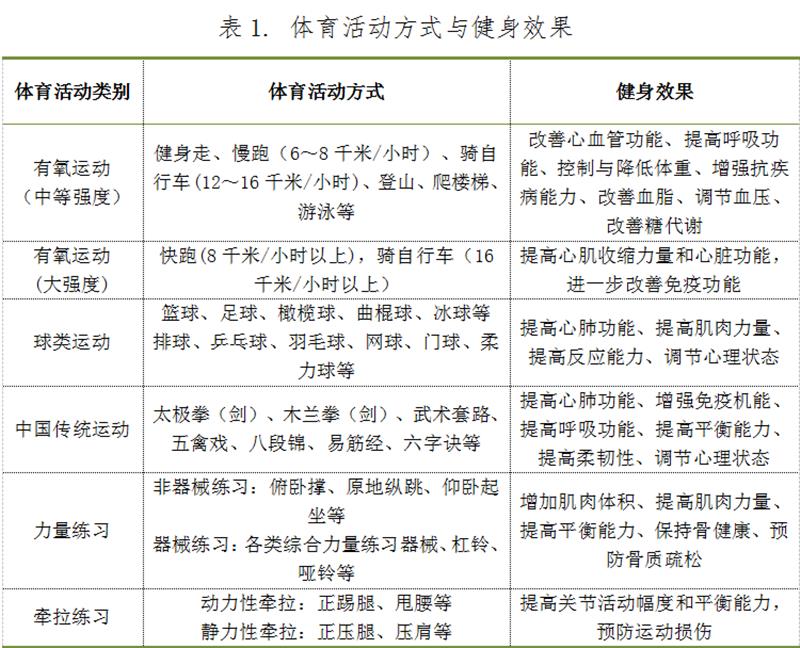
Recommend sports activities according to the purpose of sports and fitness;
— — Physical exercisers whose main purpose is to improve their physical fitness and strengthen their bodies choose their favorite physical fitness activities that can be adhered to for a long time, such as aerobic exercise, ball games and traditional China fitness exercises.
— — Physical exercisers whose main purpose is to improve heart and lung function should choose aerobic exercise, ball games and other physical fitness activities in which the whole body muscles participate.
— — Physical exercisers whose main purpose is to reduce weight should choose long-term aerobic exercise. Long-term and moderate-intensity physical fitness activities can increase body fat consumption and reduce fat content. Long-term brisk walking, jogging and cycling are ideal exercise methods to reduce weight.
— — Physical exercisers whose main purpose is to adjust their mental state should choose various recreational ball games and traditional China sports such as Tai Ji Chuan and Qigong, so as to relieve their psychological pressure and improve their sleep.
— — Sports athletes whose main purpose is to increase muscle strength can choose instrumental strength exercises and non-instrumental strength exercises according to their own fitness needs and conditions. The effect of strength exercises is related to strength load and repetition times. Generally, strength exercises with large load and few repetitions mainly develop muscle strength, while strength exercises with small load and multiple repetitions mainly develop muscle endurance.
— — Physical exercisers with the main purpose of improving flexibility can choose various pulling exercises, especially in the preparation and relaxation stages, which can not only save physical exercise time, but also achieve better fitness results. Various aerobic exercises, aerobics, Tai Ji Chuan, Qigong and yoga can improve flexibility.
— — Physical exercisers whose main purpose is to improve their balance ability can choose various special balance training methods, including sitting balance ability exercise, standing balance ability exercise and sports balance ability exercise. Tai Ji Chuan (sword), table tennis, badminton, tennis, softball and other sports can also improve the balance ability of the human body.
— — Physical exercisers whose main purpose is to improve their reaction ability can choose various ball games, such as table tennis, badminton, basketball, football and tennis, which can improve their reaction ability.
See Table 2 for the recommended sports activities according to the purpose of sports and fitness.
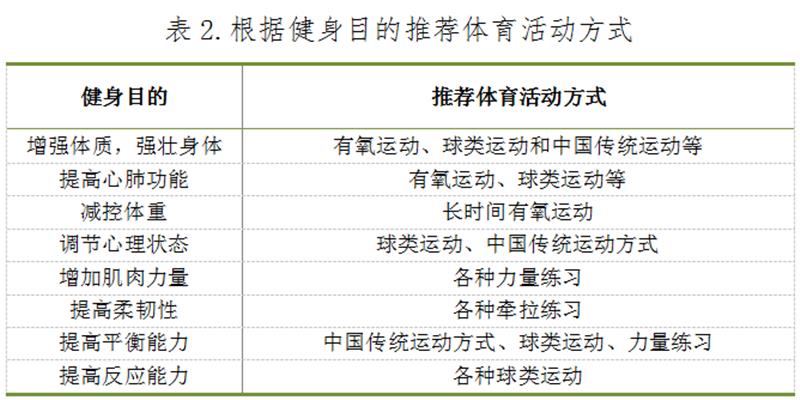
(B) the intensity of physical fitness activities
The intensity of physical fitness activities is an important content of making physical fitness activities plan. The intensity is too small, and there is no obvious fitness effect; Excessive intensity is not only bad for fitness, but also may cause sports injuries.
1, the intensity of physical fitness activities.
The intensity of physical fitness activities can be divided into three levels: low intensity, medium intensity and high intensity.
Low-intensity exercise has little stimulation to the body, and the center rate of exercise process is generally less than 100 times/minute, such as walking.
Moderate intensity exercise stimulates the body moderately, and the center rate of exercise process is generally 100 ~ 140 times/minute, such as walking, jogging, cycling, Tai Ji Chuan, tennis doubles and so on.
High-intensity exercise can stimulate the body, which can further improve the fitness effect. The sports center rate exceeds 140 times/minute, such as running, fast cycling, fast-paced aerobics and fast mountain climbing, stair climbing, tennis singles, etc.
People with good exercise habits and good physique can do high-intensity and moderate-intensity exercise; People with certain exercise habits and good physique can use moderate intensity exercise; People who participate in physical fitness activities or are weak in physique at the beginning can exercise at moderate or low intensity. Physical exercisers can adjust their exercise intensity scientifically according to their own conditions to adapt to individual conditions when implementing the physical fitness program.
2. Monitoring the intensity of physical fitness activities
The indexes for monitoring the intensity of physical fitness activities include exercise center rate, breathing changes during exercise and self-feeling during exercise.
(1) monitoring the intensity of physical fitness activities with heart rate.
The greater the intensity of physical fitness activities, the more obvious the body and heart respond to sports stimuli and the faster the heart rate. Generally, the maximum heart rate percentage and the measured heart rate during exercise are commonly used to monitor the intensity of physical exercise.
The maximum heart rate refers to the fastest heartbeat frequency that can be achieved during human movement, expressed in beats per minute. There are two methods to measure the maximum heart rate: direct measurement and indirect inference. For direct measurement, it is necessary to adopt incremental load exercise testing in special testing institutions, which requires special exercise testing instruments and equipment.
The maximum heart rate of human body is related to age, and the maximum heart rate of normal people can be calculated by the following formula: maximum heart rate (beats/minute) =220- age (year)
During physical exercise, the heart rate is 85% or above the maximum heart rate, which is equivalent to high-intensity exercise; The heart rate is controlled in the range of 60% ~ 85% of the maximum heart rate, which is equivalent to moderate intensity exercise; The heart rate is controlled in the range of 50% ~ 60% of the maximum heart rate, which is equivalent to low-intensity exercise.
In the process of physical fitness activities, when the measured heart rate reaches more than 140 beats/minute, it is equivalent to high-intensity exercise; The heart rate is in the range of 100 ~ 140 beats/min, which is equivalent to moderate intensity exercise, and the heart rate is lower than 100 beats/min, which is equivalent to low intensity exercise.
(2) Monitoring the intensity of physical fitness activities by breathing.
Physical fitness activities cause changes in human respiratory frequency and depth, and exercise intensity can be monitored according to the changes in breathing during exercise.
Breathing easily: compared with the quiet state, the breathing frequency and breathing depth change little during exercise, and breathing is stable, so you can sing. The exercise heart rate in this breathing state is generally below 100 beats/min, which is equivalent to low-intensity exercise.
Breathing is relatively easy: the breathing depth and breathing frequency increase during exercise, and normal language communication can be achieved. The exercise heart rate is equivalent to 100 ~ 120 beats/min, which is a moderate and small intensity exercise.
Shortness of breath: you can only speak short sentences during exercise, but you can’t fully express long sentences. The exercise heart rate is equivalent to 130 ~ 140 beats/min, which is a moderate intensity exercise.
Shortness of breath: it is difficult to breathe during exercise, and you can’t talk in words during exercise. Exercise heart rate generally exceeds 140 beats/min, which is a high-intensity exercise.
(3) Monitor the intensity of physical fitness activities with subjective physical sense.
Subjective physical feeling in the process of human exercise can be divided into 6-20 grades. The subjective physical feeling of low-intensity exercise is relaxed (grade 9-10), the subjective physical feeling of moderate-intensity exercise is slightly tired (grade 13-14), and the subjective physical feeling of high-intensity exercise is tired (grade 15-16).
Subjective physical sensation levels are closely related to heart rate. The number of subjective physical sensation levels during exercise is multiplied by 10, which is equivalent to the heart rate during exercise (times/minute). For example, the number of subjective physical sensation levels in exercise is 12, which is equivalent to the heart rate of 120 beats/minute in exercise.
Physical exercisers can control exercise intensity through subjective physical feeling. Generally speaking, when doing moderate-intensity aerobic exercise, the subjective physical feeling is relaxed or slightly tired.
See Table 3 for the intensity division and monitoring of physical fitness activities.

3. Strength training intensity and fitness effect
The greater the load weight of strength exercises, the greater the exercise intensity. When doing strength exercises, the maximum repetitive load (RM) is often used to indicate the magnitude of load intensity. Maximum repetitive load refers to the maximum number of strength exercises that can be repeated when a certain load is used in muscle strength exercises. For example, when a person flexes and stretches a dumbbell, the maximum load is 20kg, and it can only be repeated once, then 20kg is the maximum repeated load (1RM) of his dumbbell. If he can repeat the flexion and extension of the load-bearing arm for 8 times at most with a load of 15 kg, then 15 kg is the maximum repeated load (8RM) of his load-bearing arm for 8 times. In non-instrumental strength training, a person can complete 8 push-ups, which is equivalent to 8RM, and so on.
Strength training load intensity can be divided into three levels: low intensity, medium intensity and high intensity, and strength training intensity is closely related to fitness effect.
High-intensity strength exercises, equivalent to 1 ~ 10rm, each load weight is repeated for 1 ~ 10 times, and each part is repeated for 2 ~ 3 groups, and the interval between groups is 2 ~ 3 minutes. High-intensity strength exercises are mainly used to improve the maximum muscle contraction strength.
Moderate intensity strength exercise, equivalent to 11 ~ 20rm, the repetition times of each load weight are 10 ~ 20 times, each part is repeated in 3 groups, and the interval between groups is 1 ~ 2 minutes. Moderate intensity strength exercises can be used to improve muscle strength and increase muscle volume.
Low-intensity strength exercise, equivalent to 20RM or above, each load weight is repeated more than 20 times, each part is repeated in 2 groups, and the interval between groups is 1 minute. Low-intensity strength exercises are mainly used to develop muscle endurance.
(3) Time for physical fitness activities
The time of each physical fitness activity directly affects the effect of physical fitness activities. Exercise time is too short, which has little effect on improving physical function; However, if the exercise time is too long, it will easily cause fatigue accumulation and will not further increase the fitness effect. For people who often participate in physical exercise, the effective physical fitness activity time is 30 ~ 90 minutes every day. In the initial stage of participating in physical fitness activities, the exercise time can be slightly shorter; After a period of physical fitness activities, the body can adapt to sports and can extend the exercise time. Physical fitness activities can be carried out once a day or several times separately, and each physical fitness activity should last for more than 10 minutes.
People who are used to physical fitness activities should exercise for 3-7 days a week, with 30-60 minutes of moderate-intensity exercise or 20-25 minutes of high-intensity exercise every day. In order to achieve the ideal effect of physical fitness activities, we should carry out moderate-intensity exercise for more than 150 minutes or high-intensity exercise for more than 75 minutes every week; If you have good exercise habits, and the comprehensive evaluation of exercise ability test is above good, you can do 300 minutes of moderate-intensity exercise or 150 minutes of high-intensity exercise every week, and the fitness effect is better.
Six, the content and arrangement of a physical fitness activity
A complete physical fitness activity should include three parts: preparation activity, basic activity and relaxation activity, as shown in Table 4.
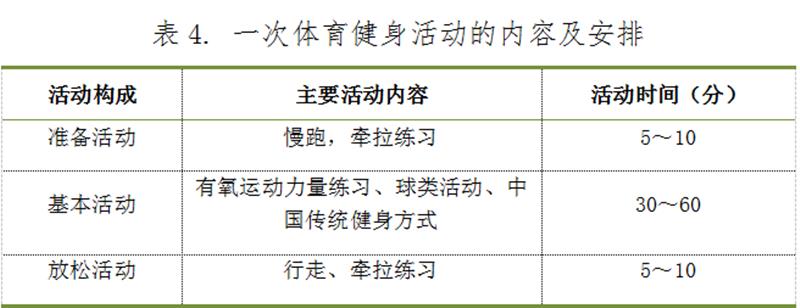
(1) Preparatory activities
Warm-up activities refer to various physical exercises before the start of major physical fitness activities. The main function of warm-up activities is to mobilize the functional potential of heart, lungs, muscles and other organ systems in advance, so as to adapt to the upcoming various fitness activities, obtain the best exercise fitness effect, and effectively prevent acute and chronic sports injuries.
The preparation time is generally 5 ~ 10 minutes, which mainly includes two aspects. First, carry out proper aerobic exercise, such as brisk walking and jogging, so as to "warm up" various organ systems of the body and enter the working state in advance; The second is to carry out various traction exercises to increase joint mobility, improve the elasticity of soft tissues such as muscles and ligaments, and prevent muscle injury.
(2) Basic activities Basic activities are the main forms of physical exercise, including aerobic exercise, strength exercise, ball games and traditional China sports and fitness methods, which generally last for 30-60 minutes. In a physical fitness activity, it is necessary to choose a suitable exercise mode and control the appropriate exercise intensity and exercise time. In the arrangement of physical fitness activities in a week, physical fitness activists can have different physical fitness activities and exercise intensity according to their own situation. See Table 5 for the arrangement of exercise intensity, duration and exercise frequency of different physical fitness activities.
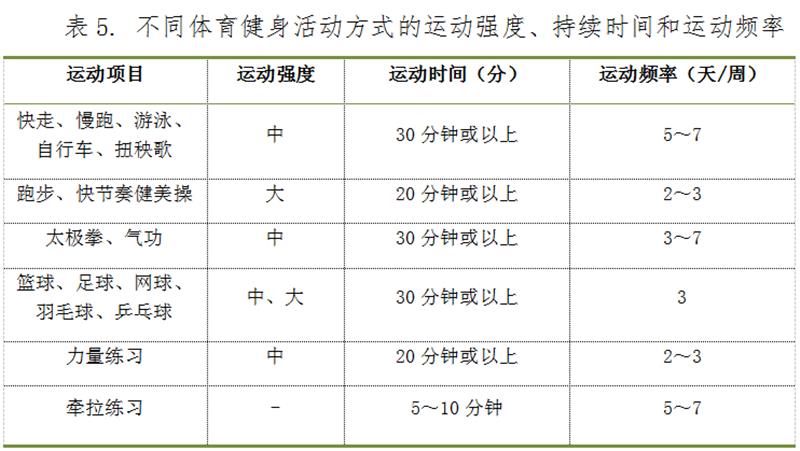
(3) Relaxation activities
Relaxation activities refer to all kinds of physical activities after the main physical fitness activities, mainly including low-intensity activities such as walking (or jogging) and various pulling exercises. After physical fitness activities, doing some moderate relaxation activities will help to eliminate fatigue, alleviate or avoid some uncomfortable symptoms in the body, and gradually restore the functions of various organs and systems of the body from the exercise state to the quiet state. Doing some traction exercises is conducive to improving the flexibility of the body.
Seven, different stages of physical fitness activities.
(A) the initial physical fitness program
People who have just participated in physical fitness activities have less exercise load, and the duration of each physical fitness activity is relatively short, so that the body gradually adapts to the exercise load and the exercise ability is gradually improved. At the beginning of the physical fitness activity plan, you should choose the physical fitness activity mode that you like or conform to the fitness purpose. There should be a comfortable sense of fatigue after exercise, which basically disappears the next day after exercise.
At the beginning of physical fitness activities, the principle of increasing exercise load is to increase the daily exercise time, then increase the number of days of exercise per week, and finally increase the intensity of exercise.
The initial period of physical fitness activities is about 8 weeks, and the specific plan is as follows:
— — Exercise mode: moderate intensity aerobic exercise, ball games, China traditional exercise mode and flexibility exercise.
— — Exercise intensity: 55% of the maximum heart rate, gradually increasing to 60%.
— — Duration: Exercise for 10-20 minutes each time, and gradually increase to 30-40 minutes.
— — Exercise frequency: 3 days/week, gradually increasing to 5 days/week.
See Table 6 for an example of the initial physical fitness program.
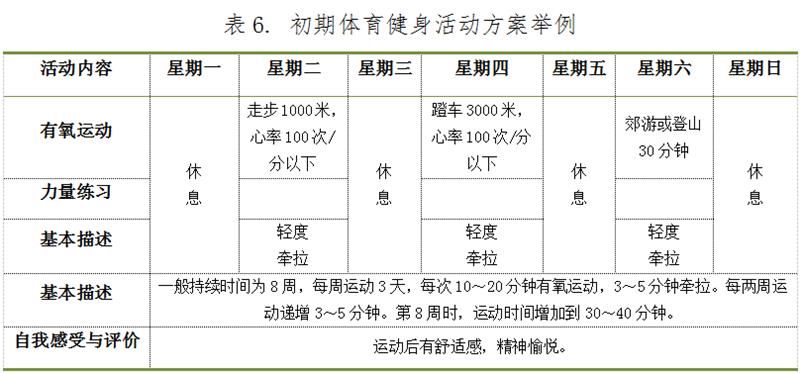
(2) Medium-term sports fitness program
After 8 weeks of physical fitness activities, the human body basically adapts to the exercise load at the initial stage of exercise, and its physical function and exercise ability are improved, so it can enter the middle stage of physical fitness activities. At this stage, continue to increase the intensity and time of exercise, and gradually increase the time of moderate-intensity aerobic exercise to 150 minutes or more per week, so that the body can adapt to moderate-intensity aerobic exercise. The medium-term physical fitness activities last about 8 weeks, and the specific plan is as follows:
— — Exercise mode: maintain the initial mode of physical fitness activities; Increase strength exercises appropriately.
— — Exercise intensity: aerobic exercise intensity gradually increases from 60% ~ 65% of the maximum heart rate to 70% ~ 80% of the maximum heart rate; Anaerobic exercise can be arranged once a week, and the strength exercise uses a load of more than 20RM, which is repeated 6 ~ 8 times.
— — Duration: 30 ~ 50 minutes for each exercise; If anaerobic exercise is arranged, exercise for 10 ~ 15 minutes each time; 1 ~ 2 strength exercises once a week, 6 ~ 8 kinds of muscle strength exercises each time, and 1 ~ 2 groups are repeated for 5 ~ 10 minutes.
— — Exercise frequency: 3 ~ 5 days/week.
At this stage, the physical fitness program is basically fixed, and gradually transitions to a long-term and stable physical fitness program. See Table 7 for examples of mid-term physical fitness activities.
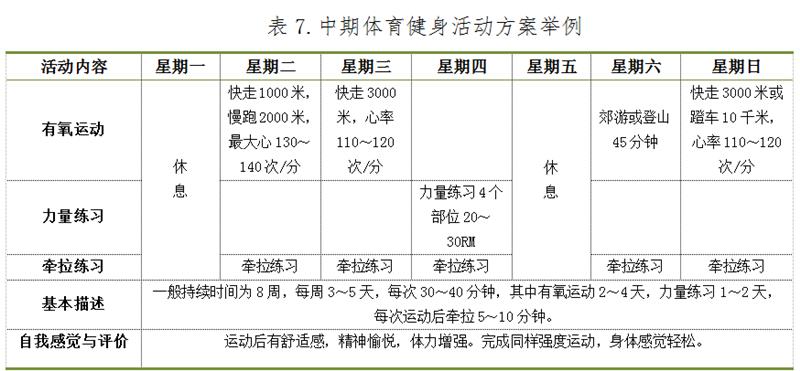
(3) Long-term physical fitness program
When the physical function reaches a higher level and good habits of physical fitness activities are formed, a long-term stable physical fitness activity plan suitable for one’s own characteristics should be established. Long-term and stable physical fitness activities should include at least 200-300 minutes of moderate-intensity exercise or 75-150 minutes of high-intensity exercise every week; Carry out strength exercises 2 ~ 3 times a week, and pull exercises no less than 5 times. The specific scheme is as follows:
— — Exercise mode: maintain the exercise mode in the middle stage of physical fitness activities.
— — Exercise intensity: moderate intensity exercise is equivalent to 60% ~ 80% of the maximum heart rate, and high intensity exercise reaches more than 80% of the maximum heart rate; Strength exercises are performed with a load of 10 ~ 20 rm and repeated for 10 ~ 15 times; All kinds of pulling exercises.
— — Duration: 30-60 minutes of moderate intensity exercise each time, or 15-25 minutes of high intensity anaerobic exercise, or alternating moderate and high intensity exercise; 8 ~ 10 kinds of muscle strength exercises, each repeated 2 ~ 3 groups, each time for 5 ~ 10 minutes of stretching exercises.
— — Exercise frequency: exercise for 5 ~ 7 days/week, and high-intensity exercise should not exceed 3 times per week.
See Table 8 for examples of long-term physical fitness activities.
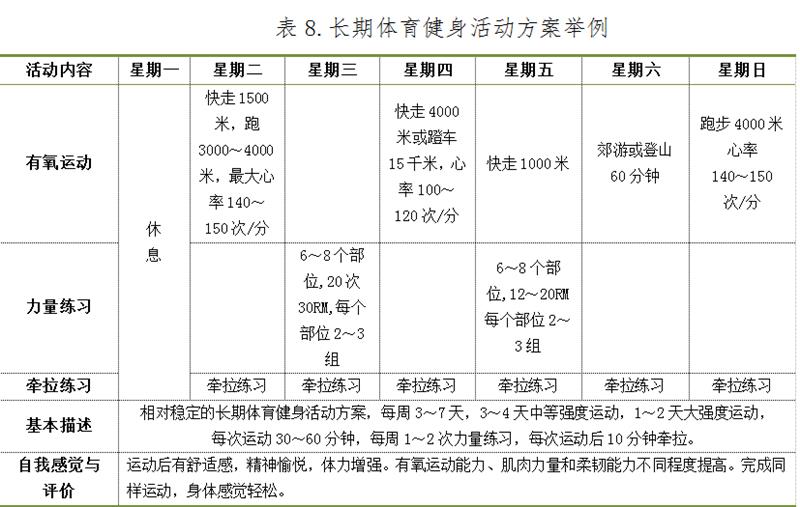
[Close window]